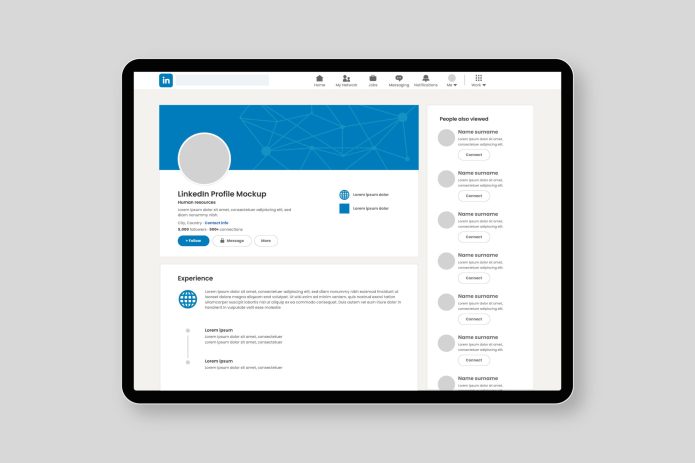The Official Tech4states Blogs

Want to unlock job opportunities, connect with influential people, and build a magnetic personal brand? You’re not alone. LinkedIn has evolved from a digital resume holder into the platform for career growth and networking. If you’re wondering how to improve your LinkedIn profile, you’re in the right place.
In this guide, I’ll walk you through simple yet powerful steps to transform your LinkedIn presence, and help you achieve your professional goals. Whether you’re aiming to attract recruiters, grow your network, or showcase your personal brand, this is your complete roadmap to improve LinkedIn profile effectiveness from top to bottom.
Table of Contents
ToggleWhy Your LinkedIn Profile Matters More Than Ever
According to LinkedIn, users with complete profiles are 40 times more likely to receive opportunities. Whether you’re a student eyeing internships, a freelancer looking for gigs, or an entrepreneur building a network, a polished profile is a game-changer.
Career coach Austin Belcak highlights this shift clearly: “LinkedIn is the new resume, portfolio, and personal website — all rolled into one.” With recruiters increasingly relying on digital footprints, your LinkedIn profile is often your first impression.
Step 1: Improve LinkedIn Profile Photo First
First impressions matter. A professional, friendly profile photo builds trust instantly.
Tips:
- Use a high-resolution image.
- Wear professional attire suitable for your industry.
- Smile genuinely to appear approachable.
- Ensure the background is clean and not distracting.
Bonus Tip: Consider using an AI professional headshot tool such as Profile Bakery if you don’t have access to professional photography.
Fact: Profiles with a photo get 21 times more profile views and 36 times more messages.
As Madeline Mann wisely suggests, “A strong visual presence sets the tone for how recruiters perceive your professionalism and energy even before reading a single word.”
Step 2: Nail Your Headline
Your headline isn’t just your job title. It’s your brand in a sentence.
Instead of “Marketing Specialist,” say “Helping Brands Grow Revenue Through Strategic Digital Marketing | SEO, Content, Paid Ads.”
Formula: [Role/Skill] + [Benefit You Provide] + [Specialization/Industry Keywords]

Step 3: Craft an Engaging About Section
Think of the “About” section as your elevator pitch.
Structure it like this:
- Hook: Start with a bold statement or question.
- Summary: Highlight your achievements and passions.
- Mission: What drives you professionally?
- Call to action: Invite people to connect or collaborate.
Example:
Passionate about building software that transforms industries. With 5+ years in fintech, I specialize in developing scalable web applications. Always open to collaborating on innovative projects — let’s connect!
As Jeremy Schifeling, former LinkedIn Education Marketing Lead, explains, “Your About section isn’t just about you — it’s about what you can do for others. Make it resonate.”
Step 4: Improve LinkedIn Profile Work Experience Section
Don’t just list job duties — showcase your impact.
How:
- Use bullet points.
- Focus on achievements, not tasks.
- Quantify results (“Increased sales by 30% in six months”).
Pro Tip: Reflect keywords relevant to your industry — recruiters often search by them!
If you’re a small business owner or freelancer, frame your experience in terms of measurable growth. For example, “Generated 120% ROI through targeted campaigns.” To learn how digital marketing can amplify business growth and visibility, check out this guide on digital marketing for small businesses.
Insight: “Every bullet point should show growth, achievement, or contribution,” stresses career strategist Austin Belcak.

Step 5: Feature Skills Strategically
You can add up to 50 skills, but quality beats quantity.
Best practices:
- Prioritize the top 3 skills; they are most visible.
- Align skills with your career goals.
- Regularly update them based on new learnings.
Tip: Endorse peers’ skills authentically; often, they’ll return the favor!
Step 6: Gather Authentic Recommendations
Real testimonials boost your credibility immensely.
How to Get Recommendations:
- Ask former managers, clients, professors, or colleagues.
- Personalize your request.
- Offer to write a draft they can edit.
Example request:
Hi [Name], I’m updating my LinkedIn and would appreciate a short recommendation based on our work together at [Company/Project]. Happy to return the favor!
Step 7: Customize Your LinkedIn URL
A clean URL looks professional on resumes and business cards.
How:
- Go to “Edit public profile & URL.”
- Customize it to something like: linkedin.com/in/yourfullname
Step 8: Engage and Create Content
Your profile isn’t static. Active users are favored by LinkedIn’s algorithm.
Easy ways to engage:
- Share relevant articles with your commentary.
- Comment thoughtfully on others’ posts.
- Publish short posts about your industry insights.
Stat: Regular activity can increase your profile visibility by up to 130%.
As Madeline Mann points out, “Thought leadership on LinkedIn doesn’t require you to be an expert — just willing to share your authentic experiences and lessons learned.”
One underrated tactic is to share insights from your own blog or curated articles. For B2B professionals, this could mean promoting your content or others’ thoughtful takes on industry trends. Not sure what to post? Consider whether you’re doing enough to promote your B2B blog, it’s an effective way to position yourself as a thought leader while building credibility with your network.
Alt text: Engagement boost stats for improving your LinkedIn profile
Step 9: Use Featured Section to Highlight Work
Showcase media like blog posts, project portfolios, certifications, or interviews.
Tip: Add visuals whenever possible, images and videos stand out more than plain text.
If you’ve collaborated with consultants or agencies in niche areas, such as automating reports or building tools, don’t hesitate to showcase those projects. For instance, partnering with an Excel macro consultant to streamline business operations could be a unique selling point, especially in technical or operations-heavy industries.
Step 10: Follow the Official LinkedIn Profile Guide to Continuously Improve LinkedIn Profile Standards
LinkedIn evolves constantly. Following their latest guidelines ensures you stay ahead.
How to Improve LinkedIn Profile for Recruiters
To truly stand out to recruiters, tailor every section of your profile with precision. Recruiters are scanning for specific keywords, measurable results, and a sense of personality. Improve LinkedIn profile appeal by:
- Using industry-specific language in your About and Experience
- Uploading visual proof of achievements
- Writing in an active, confident tone
Think like a recruiter: if you were hiring for your dream role, what would you look for?

Build Relationships, Not Just a Network
While expanding your LinkedIn connections is important, the real value lies in the quality of those relationships. It’s easy to fall into the trap of collecting contacts without ever engaging meaningfully. But true professional growth comes from interactions that are intentional, respectful, and mutually beneficial. Whether it’s through thoughtful comments, direct messages, or content collaboration, investing in building meaningful relationships can transform your LinkedIn experience from transactional to transformational.
Bonus Expert Advice: Different Perspectives on Winning LinkedIn
Feedback-Driven Growth and the Future-Focused Profile
According to Madeline Mann, founder of Self Made Millennial, the best way to improve your LinkedIn profile is to align it with the opportunities you aspire to — not just what you’ve done in the past. She emphasizes using feedback from peers, mentors, or even LinkedIn coaches to rework your “About” and headline sections to better reflect where you’re heading. “Focus your profile on the future — where you’re going, not just where you’ve been,” she advises. Conducting informal surveys or feedback questionnaires from trusted connections can reveal blind spots and spark meaningful improvements. Consider creating a short, structured survey to collect feedback from peers or mentors. By implementing this approach, it can give you objective insights into how your profile is perceived. Here’s a practical guide on how to create a questionnaire for gathering feedback effectively.
The Power of Keyword Compliance and Strategic Language
Jeremy Schifeling, a former LinkedIn Marketing Lead, stresses the importance of staying compliant with how LinkedIn’s search algorithm operates. To improve LinkedIn profile visibility, your language must strategically match job titles, skills, and industry-specific terms. “Keywords are crucial,” Jeremy says. “LinkedIn’s search is driven by keywords, so plant them strategically in your headline, summary, and experience.” He recommends running a keyword audit — similar to what you’d do on a website — to ensure you’re not just compliant, but competitive in recruiter searches.
Writing with Purpose and Framing Personal Growth
Austin Belcak, founder of Cultivated Culture, believes every element of your profile should demonstrate progression and intention. “Every word on your profile should be a stepping stone to your next opportunity,” he shares. Instead of mirroring your resume, he suggests using LinkedIn as a narrative of personal and professional growth. This mindset helps improve LinkedIn profile storytelling, making it not just a static page, but a compelling showcase of who you are becoming. He encourages professionals to update their profiles as they grow — treating it like a living document, not a finished product.
Craft your profile with the same intentionality you’d apply to your company’s branding. Just like a business thrives on a clear brand identity, professionals benefit from strong personal branding. For actionable insights, explore these expert brand strategy consulting tips that can also be adapted to elevate your personal presence.
Final Thoughts
Improving your LinkedIn profile is an ongoing process, not a one-time task. A great profile can unlock doors you didn’t even know existed — job offers, partnerships, mentorship opportunities, and more.
Take it step-by-step, keep it authentic, and don’t forget: your LinkedIn profile is the digital handshake that often comes before the real one.
Remember the wise words of Austin Belcak: “Make your profile a magnet, not a mirror.”
FAQs About Improving Your LinkedIn Profile
Q1: How often should I update my LinkedIn profile?
Ideally, review it every 3–6 months or whenever you have a new achievement, skill, or certification.
Q2: Should I accept all connection requests?
Quality over quantity. Connect with people relevant to your industry, goals, or interests.
Q3: Is LinkedIn Premium worth it for job seekers?
For active job seekers, LinkedIn Premium can offer valuable insights and InMail credits, but it’s not essential to improving your profile.
Q4: How important are endorsements?
While not as strong as recommendations, a well-endorsed skill section adds credibility.
Q5: Can I use the same content from my resume?
Not exactly. LinkedIn allows for a more personal tone. Be professional but conversational.
Q6: What’s one mistake to avoid on LinkedIn?
Avoid using buzzwords without substance. Show your achievements instead of just saying you’re “innovative” or “passionate.”
Q7: How can I improve LinkedIn profile visibility fast?
Focus on your headline, add a high-quality photo, complete every section, and engage weekly. These actions will quickly improve LinkedIn profile performance.

Start Your Project
Our Expert Are Waiting to Discuss
Your Project Details.
Tech4states Helping brands to digitally transform with a spice of innovation and technical expertise.

 (239) 215-2006
(239) 215-2006